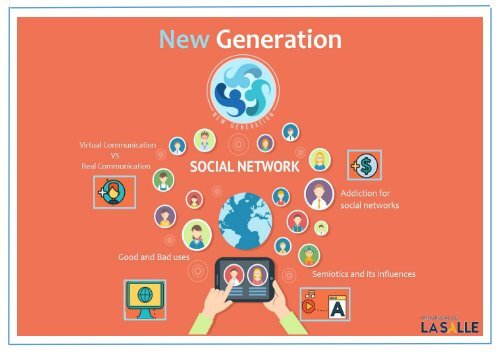Revista New Generation final
Create successful ePaper yourself
Turn your PDF publications into a flip-book with our unique Google optimized e-Paper software.
Índex<br />
Virtual Communication VS. Real communication ………………………….1<br />
Multiliteracy and Social Networks in Higher Education…………….3<br />
Good and Bad Uses of Social Networks……………………………………4<br />
Social Network’s addiction…………………………………………………6
1<br />
Virtual Communication VS. Real communication<br />
This article contrasts the advantage and disadvantage of face-to-face communication or virtually<br />
FACE-TO-FACE COMMUNICATION<br />
Face to face communication is an informal discussion through spoken language and words on a particular<br />
issue among the people to exchange their views<br />
Advantages:<br />
Effective Communication: you can observe what the interlocutor facial expression when you express your<br />
ideas<br />
Instant Feedback: Doubts and understandings are cleared on the stop so if you have some inconsistency in<br />
your speech you interlocutor says you which are when you finish.<br />
Confidential: all secrets and confidents matters are revealed to the trusted person privately<br />
Disadvantages:<br />
Unsuitable for some people: face to face communication is not possible a proper rapport<br />
with a large group.<br />
Not accountable: it´s difficult to hold someone responsible or accountable<br />
for something spoken face to face.
2<br />
Virtual Communication VS. Real communication<br />
VIRTUAL COMMUNICATION<br />
Information-Communication is a general expressing for a variety of different computer, information and<br />
communication devices, application, network and services<br />
Advantage:<br />
Speed the sending of information: communications technology tool like electronic mail and text messaging<br />
system can share information in a fast way,<br />
Influence the people interact with others: with the network the people share different cultures or<br />
languages through the virtual communication.<br />
Flexibility: the communication is global<br />
Disadvantage:<br />
Poor face to face communication: since the persons are using machines to communicate,<br />
they get less time to talk to other persons this include the family and other close friends.<br />
False Identities: some people supplant their identities
3<br />
Multiliteracy and Social Networks in Higher Education
4<br />
There are so many ways to use social networks, we use it for stay in touch with friends,<br />
family, work; to stay up to date with news, to fill up spare time, to share opinions,<br />
pictures, photos, videos; to meet new people, to share events or details of our daily life<br />
etc. but According to Small (2015) in his research called “The impact social networking<br />
has on the united states national security”, says that “social networking connects<br />
people globally and enables users to share every aspect of their life with the click of a<br />
button. Exact locations, real time photos, personal videos and even a particular<br />
thought a user had can be instantly uploaded in a matter of seconds” but, how can we<br />
use social networks properly to not create addiction?<br />
Picture taken from http://www.freepik.com/free-vector/socialnetwork-user-cartoon_746487.htm#term=social
5<br />
Here, you can find some authors that give us advice to use social networks properly to not create<br />
addiction; For example, Cha (2010) explored the factors that affect the use of social networks and<br />
focused on two dimensions of social networks use: frequency (how often people use social<br />
networks) and amount (how much time people spend on social networks). And he says that<br />
people should have the control about the frequency and the time that they use in social networks<br />
On the other hand Gupta, Arora, and Gupta (2013) They advise to follow these strategies to manage<br />
and treat SNS addiction:<br />
• Recognize the signs of a social networks addiction.<br />
• Start questioning what you are doing on social networks<br />
• Write down exactly how much time you spend on each site.<br />
• Decide what is of value on social networks<br />
• Give yourself a set time of the day to visit social networks<br />
Picture taken from: http://www.freepik.com/freevector/business-banners-set_957428.htm#term=social
6<br />
Social Network’s addiction<br />
Nowadays technology and internet is incorporate more in our<br />
lives, social network is an example of that. We use them to<br />
communicate, to be informed, to work, etc. but do you know how<br />
much time we spend in these ones?<br />
The article “How Much Time Do People Spend on Social Media?”<br />
written by Evan Asano says:<br />
“The amount of time people spend on social media is constantly<br />
increasing. Teens now spend up to nine hours a day on social<br />
platforms, while 30% of all time spent online is now allocated to<br />
social media interaction. And the majority of that time is on mobile<br />
- 60% of social media time spent is facilitated by a mobile device.”<br />
(Asano. 2017)<br />
As the article says, teens are the people who spend most of the<br />
time on social networks, and is increasing because each one is get<br />
more interesting and attractive for them.<br />
“Currently, total time spent on social media<br />
beats time spent eating, drinking,<br />
socializing and grooming.”(Asano.2017)<br />
Picture taken from:<br />
http://www.freepik.com/fre<br />
e-vector/people-usingtechnologygadgets_774644.htm#term=<br />
social
References<br />
Flaherty, L. M., Pearce, K. J., & Rubin, R. B. (1998). Internet and face‐toface<br />
communication: Not functional alternatives. Communication<br />
Quarterly, 46(3), 250-268.<br />
Nardi, B. A., & Whittaker, S. (2002). The place of face-to-face<br />
communication in distributed work. Distributed work, 83-110.<br />
Small, C. (2015) the impact social networking has on the United States<br />
national security. Master of Science in Cybersecurity. United States.<br />
Located at.<br />
http://search.proquest.com/openview/ef0ceaa780966f115e6f1de8bfd6e<br />
714/1?pq-origsite=gscholar&cbl=18750&diss=y<br />
Gupta, V. K., Arora, S., & Gupta, M. (2013). Computer-related illnesses<br />
and Facebook syndrome: What are they and how do we tackle them?<br />
Medicine Update, 23, 676–679<br />
Cha, J. (2010). Factors affecting the frequency and amount of social<br />
networking site use: Motivations, perceptions, and privacy concerns.<br />
First Monday, 15(12). Located at<br />
http://firstmonday.org/ojs/index.php/fm/article/viewArticle/2889/2685<br />
Ellison, N. B. (2007) ‘Social network sites: Definition, history, and<br />
scholarship! Journal of Computer-Mediated Communication Vol. 13,<br />
Issue 1, p210-230, Blackwell.<br />
Rienties, B., Tempelaar, D., Van den Bossche, P., Gijselaers, W., & Segers,<br />
M. (2009). The role of academic motivation in Computer-Supported<br />
Collaborative Learning. Computers in Human Behavior, 25(6), 1195-1206.



